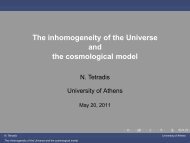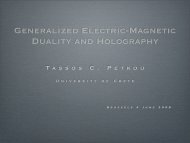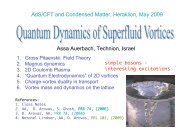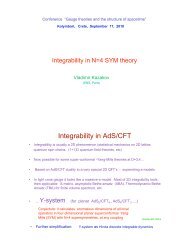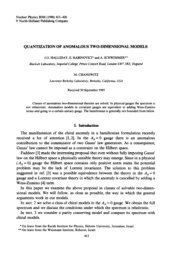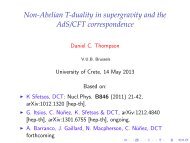de Sitter space and Holography
de Sitter space and Holography
de Sitter space and Holography
- No tags were found...
You also want an ePaper? Increase the reach of your titles
YUMPU automatically turns print PDFs into web optimized ePapers that Google loves.
<strong>de</strong> <strong>Sitter</strong> <strong>space</strong> <strong>and</strong> <strong>Holography</strong>Third Crete Regional Meeting in string theory,June 23-July 2, 20051
Plan of talk1. Historical review <strong>and</strong> motivation2. <strong>de</strong> <strong>Sitter</strong> <strong>space</strong> <strong>and</strong> its properties3. dS/CFT correspon<strong>de</strong>nce4. dS/dS correspon<strong>de</strong>nce2
1. Historical review <strong>and</strong> motivation• In 1917 the cosmological constant Λ was introduced byEinstein to get static homogeneous universe in the present ofmatter.• In 1920 Slipher’s works showed that the light from galaxieswas redshifted indicating that they are moving away from us.• In 1922 a matter dominated exp<strong>and</strong>ing universe withoutcosmological constant was constructed by Friedmann.• In 1923 in a letter to Weyl, Einstein says“ If there is no quasi-static world, then away withcosmological term.”• In 1927 the conclusive discovery was ma<strong>de</strong> by HubbleA linear expansion law relating redshift to distance whichma<strong>de</strong> Friedmann mo<strong>de</strong>ls the st<strong>and</strong>ard geometrical framework.3
For pure dS <strong>space</strong> where the energy-momentum tensor ofthe matter field vanishes, one may consi<strong>de</strong>r the <strong>space</strong>time as asolution of the Einstein equation for an empty <strong>space</strong>time witha positive constant vacuum energyT vacµν = Λ8πG g µν → R µν − 1 2 g µνR = −g µν ΛTherefore the only non-trivial component of the Einsteinequation isR = 2dd − 2 Λ > 0An interesting observation about the dS d <strong>space</strong> is itsembedding into the flat d + 1 dimensional <strong>space</strong> time. Ind + 1 dimensional Minkowski <strong>space</strong>time the Einstein equationis trivially satisfied0 = d+1 R ≡ g AB R AB forA, B = 0,...,d= R + R ddIf we set R dd = − 2dd−2Λ( which means positive constantcurvature of embed<strong>de</strong>d <strong>space</strong>) one getsR = 2dd − 2 Λ (dS Space) 6
5. Technologies:There are a number of types of touchscreen technologies. Some of them are5.1 InfraredIn this technology infrared(IR) light-emitting dio<strong>de</strong>s(LEDs) are placed at theopposite edges [ aks. Bezel edges] to analyze the system <strong>and</strong> <strong>de</strong>tect the touch event.The LED<strong>and</strong> photosensor pairs create a grid of light beams across the display. An object (such as a fingeror pen) that touches the screen interrupts the light beams, causing a measured <strong>de</strong>crease in light atthe corresponding photosensors. The measured photosensor outputs can be used to locate atouch-point coordinate.Wi<strong>de</strong>spread adoption of infrared touchscreens has been hampered by two factors: the relativelyhigh cost of the technology compared to competing touch technologies <strong>and</strong> the issue ofperformance in bright ambient light. This latter problem is a result of background lightincreasing the noise floor at the optical sensor, sometimes to such a <strong>de</strong>gree that the touchscreen’sLED light cannot be <strong>de</strong>tected at all, causing a temporary failure of the touch screen. This is mostpronounced in direct sunlight conditions where the sun has a very high energy distribution in theinfrared region.However, certain features of infrared touch remain <strong>de</strong>sirable <strong>and</strong> represent attributes of the i<strong>de</strong>altouchscreen, including the option to eliminate the glass or plastic overlay that most other touchtechnologies require in front of the display. In many cases, this overlay is coated with anelectrically conducting transparent material such as indium-tin oxi<strong>de</strong> (ITO), which reduces theoptical quality of the display. This advantage of optical touchscreens is extremely important formany <strong>de</strong>vice <strong>and</strong> display vendors since <strong>de</strong>vices are often sold on the perceived quality of the userdisplay experience.Another feature of infrared touch which has been long <strong>de</strong>sired is the digital nature of the sensoroutput when compared to many other touch systems that rely on analog-signal processing to<strong>de</strong>termine a touch position. These competing analog systems normally require continual recalibration,have a complex signal-processing <strong>de</strong>m<strong>and</strong> (which adds cost <strong>and</strong> powerconsumption), <strong>de</strong>monstrate reduced accuracy <strong>and</strong> precision compared to a digital system, <strong>and</strong>have longer-term system-failure mo<strong>de</strong>s due to the operating environment.7
Comparing with the Einstein equation we had which was writtenin terms of the cosmological constant one findsΛ =(d − 1)(d − 2)2l 2Therefore the dS d in the flat d + 1 dimensional Minkowski<strong>space</strong> is a hyperboloidX0X0l 2 +( X0 )2Sd-1lX , X , ..., X1 2 d8
Let us know study different coordinates systems with willbe used later. The different coordinates systems are good fordifferent purpose.Global coordinates: τ, θ i , i = 1, · · · ,d − 1This is the simplest one <strong>and</strong> can be found by just looking atthe constraint. In fact different coordinates systems correspondto the different way one can solve the constraint.Let’s <strong>de</strong>compose the constraint as follows−X 2 0 + (X 2 1 + · · · + X 2 d) = l 2so the solution isX 0 = l sinh τ l , X i = lω i cosh τ l, for i = 1, ...,dfor −∞ < τ < ∞. Here ∑ i ω2 i = 1 parameterize a S d−1sphereω 1 = cos θ 1 0 ≤ θ 1 < πω 2 = sinθ 1 cosθ 2 0 ≤ θ 2 < π· · · = · · ·ω d = sinθ 1 · · ·sinθ d−1 0 ≤ θ d−1 < 2π9
The metric is given bydS 2 = −dτ 2 + l 2 cosh 2 τl dΩ2 d−1In this coordinates dS d <strong>space</strong> looks like a d − 1 sphere whichstarts out infinity large at τ = −∞ then shrinks to its minimumfinite size that τ = 0 <strong>and</strong> then grows again to infinite size atτ = ∞.In this coordinates system•∂∂θ d−1is the only Killing vector•∂∂τis NOT a Killing vector• This breaks conservation of the energy so the Hamiltonianis not well-<strong>de</strong>fined10
Conformal coordinates: T, θ i , i = 1, · · · ,d − 1Looking at the metric in the global coordinates one may writedS 2= cosh 2 τl (− dτ2cosh 2 + l 2 dΩ 2 τ d−1)l1 (=cos 2 T −dT 2 + l 2 dΩ 2 d−1)lwherecosh τ l = 1cos T l, − π 2 < T l < π 2There is one-to-one correspon<strong>de</strong>nce between this <strong>and</strong> the globalcoordinates <strong>and</strong> therefore it covers entire <strong>space</strong>.In this coordinates system•∂∂θ d−1is the only Killing vector•∂∂τis NOT a Killing vector• This breaks conservation of the energy so the Hamiltonianis not well-<strong>de</strong>fined11
Any null geo<strong>de</strong>sic with respect to the conformal metric is alsonull in the conformally rescaled metricd ˜S 2 = cos 2 T l dS2 = −dT 2 + l 2 dΩ 2 d−1Therefore this coordinates system is useful for studying thecausal structure of the dS <strong>space</strong>.12
Planer (Inflationary) coordinates: t, x i , i = 1, · · · ,d − 1Consi<strong>de</strong>r the constraint <strong>and</strong> <strong>de</strong>compose into two parts(−X0 2 + Xd) 2 + (X1 2 + · · · + Xd−1) 2 = l 2One may also consi<strong>de</strong>r a situation−X0 2 + Xd 2 = l 2 − x 2 e −2t/lX1 2 + · · · + Xd−1 2 = x 2 e −2t/l (x 2 = x i x i )which may solve as followsX 0X 0X i= l sinh t l − x22 e−t/l= l cosh t l − x22 e−t/l= x i e −t/lfor −∞ < x i < ∞ <strong>and</strong> −∞ < t < ∞.13
Let’s consi<strong>de</strong>r X 0 − X d which turns out to beX 0 − X d = −le −t/l ≤ 0Therefore this coordinates does not cover the entire <strong>space</strong>time.In fact it just cover only half of it which in our convention it isgiven by the following figure.X 0X 0 = −X d X 0 = X dlX d14
The corresponding metric isdS 2 = −dt 2 + e −2t/l dx i dx iIn this coordinates system•∂∂x ifor i = 1,.., d − 1 are the Killing vectors•∂∂tis NOT a Killing vector• This breaks conservation of the energy so the Hamiltonianis not well-<strong>de</strong>fined15
Static coordinates: t,r, θ i , i = 1,...d − 2There is another way to solve the constraint in which it is<strong>de</strong>composed as followswith(−X 2 0 + X 2 d) + (X 2 1 + · · · + X 2 d−1) = l 2−X 2 0 + X 2 d = l 2 − r 2X 2 1 + · · · + X 2 d−1 = r 2which can be solved by the following parametrizationX 0= √ l 2 − r 2 sinh t lX d = √ l 2 − r 2 cosh t lX i = rω i , i = 1,....d − 116
It is easy to see thatX 0 + X d = √ l 2 − r 2 e t/l ≥ 0X 0 − X d = − √ l 2 − r 2 e −t/l ≤ 0Therefore this coordinates system can not cover whole<strong>space</strong>time. In fact it just cove quarter of it which in ourconvention is given by the following figureX 0X 0 = −X d X 0 = X dlX d17
The corresponding metric is given bydS 2 = −(1 − r2l 2 )dt2 + dr21 − r2l 2 + r 2 dΩ 2 d−2In this coordinate system•∂∂t <strong>and</strong>∂∂θ d−2are Killing vectors• Hamiltonian is well-<strong>de</strong>fined in the static coordinates butunitarity is threatened by the existence of the horizon atr = l . Note that in this coordinates 0 ≤ r < l.18
1.2 Causal structure (Penrose diagram)Using a conformal factor Ω 2 = cos 2 T one may bring in thepoints at infinity to a finite position so that the whole <strong>space</strong>timeis shrink into a finite region called Penrose diagram.Since a conformal map does not change the causal structure,this may use to study the causal structure of the dS <strong>space</strong>,though the distances are highly distorted.We would like to study causal structure in various coordinatesin terms on the Penrose diagram.d ˜S 2 = cos 2 TdS 2 = −dT 2 + l 2 dΩ 2 d−1One may write this as follows−dT 2 + dθ 2 1 + sin 2 θ 1 dΩ 2 d−2,0 < θ 1 < πΙ + (T/l= π /2 = )( = 0) θ1North PoleSurface ofconstant T (or )Time line ofconstant ( θ 1 , θ2 , ... , θd-1 )South Pole ( θ1 = π )Ι − (T/l=- π /2 = − )20
INorth PoleSouth PoleI1) North <strong>and</strong> South poles are timelike line.2) Every point in the interior represents an S d−2 .3) A horizontal slice is an S d−1 .4) I − <strong>and</strong> I + are past <strong>and</strong> future null infinity. They are thesurfaces where all null geo<strong>de</strong>sics originate <strong>and</strong> terminate.5) The dashed lines are the past <strong>and</strong> future horizons of anobserver at the south pole.Therefore no single observer can see entire <strong>space</strong>time.21
IINorth PoleOSouth PoleNorth PoleOSouth PoleII1) An observer in the south pole cannot see anything pastthe diagonal line stretching from the north pole at I − to southpole at I + :O − region .2) O + is the only part that an observer in south pole cansend a signal to.3) The planer coordinate we were talking about covers O −region. (In our notation)4) Changing t → −t the coordinates will cover O + region.5) O − ⋂ O + is the part accessible to the observer on thesouth pole (causal diamond). This is the part with is coveredby static coordinates.22
Let us to arrive at Penrose diagram from static coordinates.Starting from, t,r, θ i one <strong>de</strong>finesU = −e x− /l , V = e −x+ /lwhereTherefore we havex ± = t ± l 2ln1 + r/l1 − r/lUV = − 1 − r/l1 + r/lThe metric in this coordinates (Kruskal) is given byds 2 =l 2 [−4dUdV + (1 + UV ) 2 dΩ 2 ](1 − UV ) 2 d−2This coordinates cover all of the dS <strong>space</strong>UV = −1,UV = 0,UV = 1,rl = 0, Polesrl = 1, Horizonsrl = ∞, I± 23
The entire region of the dS <strong>space</strong> is drawn by a Penrosedigram which is a square given by |UV | = 1.VUV=1UUV=−1V=0U=0UV=−1UV=1The static patch is the region with U > 0 <strong>and</strong> V < 0.∂∂t = U l∂∂U − V lSo the norm of the Killing vector is∂∂V| ∂ ∂t |2 = 4UV(1 − UV ) 2UV = 0,UV > 0,UV < 0,null<strong>space</strong>liketimelike24
1.3 Thermal propertyConsi<strong>de</strong>r a circle with radius l : X 2 1 + X 2 2 = l 2 .X 1 = l cosθ,X 2 = l sinθThe geo<strong>de</strong>sic distance between two points on the circle is givenbyd(θ,θ ′ ) = l(θ − θ ′ )Let’s consi<strong>de</strong>r a quantity P(X,X ′ ) = 1 l 2 δ ij X i X ′ jwhich is1l 2δij X i X ′ j = cosθ cosθ ′ + sinθ sinθ ′ = cos(θ − θ ′ )Sod(θ,θ ′ ) = l cos −1 P(X,X ′ )One may generalize it for higher sphere or dS <strong>space</strong>. In thecase of the dS <strong>space</strong> given by η µν X µ X ν = l 2 one hasP(X,X ′ ) = 1 l 2ηµν X µ X ′ ν, d(1,2) = l cos −1 P(X,X ′ )25
For example• In static coordinates:l 2 P(X,X ′ ) = −√(r 2 − l 2 )(r ′2 − l 2 ) cosh t − t′l+ rr ′ cos Θwhere Θ is the geo<strong>de</strong>sic distance of two points on the unitS d−2 .• In planer coordinates:l 2 P(X,X ′ ) = −l 2 cosh t − t′l+ 1 2 e−t−t′ l δ ij (x i − y i )(x j − y j )Consi<strong>de</strong>r a scalar field in dS <strong>space</strong>S = − 1 ∫d d x √ −g[(∇φ) 2 + m 2 φ 2 ]2The Green function G(X,Y ) = 〈0|φ(X)φ(Y )|0〉 obeys(∇ 2 − m 2 )G(X,Y ) = 0Since dS <strong>space</strong> is maximally symmetric, the Green function<strong>de</strong>pends on X <strong>and</strong> Y only through P(X,Y ).26
For any function f(P) one can seel 2 (∇ 2 − m 2 )f(P) = (1 − P 2 ) d2 f df− PddP2dP − m2 l 2 fTherefore one has[(1 − P 2 ) d2dP 2 − Pd ddP − m2 l 2 ]G(P(X,Y )) = 0Which as solution in terms of hypergeometric functionsG = const.F(h + , h − , d 2 , 1 + P2)whereh ± = 1 [(d − 1) ± √ ](d − 1)22 − 4m 2 l 2Since the above equation is symmetric un<strong>de</strong>r P → −P thereis another solutionG = const.F(h + , h − , d 2 , 1 − P2)One parameter family of dS invariant Green functioncorresponding to a linear combination of these solutions.G α (X,Y ) = 〈α|φ(X)φ(Y )|α〉27
An observer moving along a timelike geo<strong>de</strong>sic sees a thermalbath of particles when the scalar field is in the vacuum state.<strong>de</strong> <strong>Sitter</strong> <strong>space</strong> is naturally associated with a temperature.One way to see this:Consi<strong>de</strong>r an observer sitting in south pole. In this caseP(X,X ′ ) = −cosh t − t′l= − cosh τ lOn the other h<strong>and</strong> the Green function is a function of PG(P(X,Y )) = G(cosh τ l )The Green function is periodic in imaginary time un<strong>de</strong>r τ →τ + 2πil <strong>and</strong> therefore is thermal Green function <strong>and</strong> thetemperature in given by the inverse of the periodT dS = 12πlOne can also associate entropy which is the same as blackhole <strong>and</strong> is given byS = A4Gwhere A is the area of the horizon.28
Why dS is difficult?1) dS <strong>space</strong> is inconsistent with supersymmerty: there is nosupergroup that inclu<strong>de</strong>s the isometries of dS <strong>space</strong> <strong>and</strong> hasunitary representation.2) We have not been able to embed it in string theory (up toKKLT mo<strong>de</strong>l).3) Horizon is observer <strong>de</strong>pen<strong>de</strong>nt: difficult to see where thequantum microstate we would like to count are in fact supposedto be.29
3. dS/CFT correspon<strong>de</strong>nceFrom what we have learned in AdS/CFT correspon<strong>de</strong>nce onemay hope that some kind of holography can also be appliedhere <strong>and</strong> could help us to un<strong>de</strong>rst<strong>and</strong> the quantum gravity ondS.There is a naive observation:Consi<strong>de</strong>r a AdS <strong>space</strong> with radius l, un<strong>de</strong>r l → il one getsΛ −→ −ΛAdS −→ dSSO(2,d) −→ SO(1, d + 1)Gravity on dS is dual to a Eucli<strong>de</strong>an CFT.One can make this statement more precise which is in factwhat is known as dS/CFT correspon<strong>de</strong>nce.30
How to <strong>de</strong>fine conserved charges?The <strong>de</strong>viation of the metric <strong>and</strong> other fields near spatialinfinity from the vacuum provi<strong>de</strong>s a way to <strong>de</strong>fine conservedcharges like mass, angular momentum....Equivalently the conserved charges can be computed fromthe asymptotic symmetries of a <strong>space</strong> time.For example the eigenvalue of an asymptotic timelike Killingvector will give the mass.There are two basic problems to apply this <strong>de</strong>finition for dS<strong>space</strong> (<strong>space</strong>time which is asymptotically dS):1. There is no spatial infinity.2. There is no globally <strong>de</strong>fined asymptotic timelike Killingvector.Fortunately there is a way to proceed generalizing the Brown-York construction to <strong>de</strong>fine stress tensor on the Eucli<strong>de</strong>anboundary <strong>and</strong> by using this quantity to <strong>de</strong>fine mass or othercharges for <strong>space</strong>s which are asymptotically dS.31
In d dimensions the Einstein equations with positivecosmological constant can be <strong>de</strong>rived from the actionI= I bulk + I GH∫1− d d x √ −g(R + 2Λ) + 116πG8πGM∫∂Md d−1 x √ hKhere• I GH is Gibbons-Hawking surface term which is nee<strong>de</strong>d toget a well-<strong>de</strong>fined Euler-Lagrange variation.• M is d-dimensional Manifold with Newton’s constant Gwith spatial Eucli<strong>de</strong>an boundary ∂M.• g µν is the bulk metric.• h µν <strong>and</strong> K are induced metric <strong>and</strong> the trace of the extrinsiccurvature of the boundary. The extrinsic curvature is <strong>de</strong>finedby K µν = −∇ (µ n ν) where n ν is outward pointing unit vector.• A useful length scale in the mo<strong>de</strong>l is given byl =√(d − 1)(d − 2)2ΛFor example in the vacuum dS solution, l is the radius of dS<strong>space</strong>.32
In general this action is divergent when evaluated on asolution of the equations of motion due to infinite volume ofthe <strong>space</strong>time.For example in the case of dS <strong>space</strong> <strong>and</strong> in the inflationarycoordinates one has (d = 3)I ∼ 18πG∫( ) −1d 2 xe 2t/l lwhich diverges as t → ∞.The divergence can be canceled by adding local boundarycounterterms that do not affect the equations of motion.In our case we haveI total = I + 18πG∫∂Md 2 x √ h 1 lFor dS <strong>space</strong> with two boundaries at t → ±∞, ∂M ± , we haveI total = I + 18πG∫∂M +d 2 x √ h 1 l + 18πG∫∂M −d 2 x √ h 1 lwhich has the same solution as the previous action but is finite.33
One can generalize it for a general <strong>space</strong> which isasymptotically dS. For d =, 3,4, 5 the counterterms are givenbyI ct = 18πG∫∂M +d 2 x √ hL ct + 18πG∫∂M −d 2 x √ hL ctwhereL ct = d − 2l−l 22(d − 3) R• The second term is present for d > 3.• R is the intrinsic curvature of the boundary.• The calculations are preformed by cutting off the dS <strong>space</strong>at finite time <strong>and</strong> then sending the surface to infinity.The total action is thenI total = I bulk + I GH + I ctWe can now compute the Eucli<strong>de</strong>an boundary stress tensorwhich measures the response of the <strong>space</strong>time to changes ofthe boundary metric (Brown-York prescription).Consi<strong>de</strong>r a <strong>space</strong>time with the metricds 2 = g ij dx i dx j 34
One may rewrite it as followsds 2 = g ij dx i dx j = −N 2 t dt 2 + h µν (dx µ + V µ dt)(dx ν + V ν dt)So h µν is the metric induced on surface with fixed time.Suppose u µ is the future pointing unit normal to this surface,then the extrinsic curvature is given byK µν = −h i µ∇ i u νThe stress tensor associated to the boundary is given byT µν = − 2 √hδI total=18πG[δh µνwhere G µν is the Einstein tensor of h.K µν − Kh µν − d − 2 ]h µν − lGµνl d − 3In global coordinates ( on the boundary t → −∞)T θθ = −l16πG , T φφ = − l16πG sin2 θ35
• One can always <strong>de</strong>compose the metric h µν on the equaltime surfaces as followsh νν dx µ dx ν = N ρ dρ 2 + σ ab (dφ a + U a dρ)(dφ b + U b dρ)where φ a are angular variables parameterizing closed surfaces.• Suppose the boundary has an isometry generated by aKilling vector ξ µ . One can show that T µν ξ ν is divergenceless<strong>and</strong> therefore we can <strong>de</strong>fine conserved charge associated to ξ µ .• Consi<strong>de</strong>r n µ be the unit normal on a surface of fixed ρ.Then the conserved charge is <strong>de</strong>fined∮Q = d d−2 φ √ σn µ ξ ν T µνΣPhysically this means that a collection of observers on thehypersurface whose metric is h µν would all observe the samevalue of Q provi<strong>de</strong>d this surface had an isometry generated byξ µ .Since there is no globally timelike Killing vector, it is difficultto see how the mass can be <strong>de</strong>fined in dS <strong>space</strong>. There ishowever an proposal for this using the above construction.Consi<strong>de</strong>r the case where ρ is the coordinate associated withthe asymptotic Killing vector that is timelike insi<strong>de</strong> the staticpatch but <strong>space</strong>like at I − .36
The mass of an asymptotically dS <strong>space</strong> is∮M = d d−2 φ √ σN ρ n µ n ν T µνΣOne may also <strong>de</strong>fine momenta as∮J a =Σd d−2 φ √ σσ ab n ν T bν 37
Consi<strong>de</strong>r the Brown-York stress tensor T µν for a <strong>space</strong>timewhich is asymptotically dS. One may ask the followingquestions:1. What would be the boundary conditions for the metric ifwe want the stress tensor to be finite?2. What is the most general diffeomorphism which preservesthis boundary conditions?The first question can be answered by perturbing dS <strong>space</strong><strong>and</strong> computing T µν <strong>and</strong> then one may answer to the secondquestion which will beThe conformal group of the (d − 1)-dimensional Eucli<strong>de</strong>an<strong>space</strong>.This is one of the main hints of the dS/CFT correspon<strong>de</strong>ncewhich saysQuantum gravity on dS d is dual to a (d − 1)-dimensionalEucli<strong>de</strong>an conformal field theory residing on the past boundaryI − of dS d .This CFT may be non-unitary!To see how this works, let’s consi<strong>de</strong>r an explicit example;dS 3 .38
Consi<strong>de</strong>r dS 3 <strong>space</strong> in the planar coordinates (l = 1)ds 2 = −dt 2 + e −2t dzd¯zConsi<strong>de</strong>r a perturbation around this metric g ij + γ ij so thatds 2 = g ij dx i dx j = −dt 2 + e −2t dzd¯z + γ ij dx i dx jwhich can be recast into the following formds 2 = −Ndt 2 + h µν (dx µ + V µ dt)(dx ν + V ν dt)Therefor the induced metric readsh zz = γ zz , h z¯z = 1 2 e2t + γ z¯z , h¯z¯z = γ¯z¯zThe outward pointing unit normal vector is also given bySo we findn µ = (1 − γ tt, 0, 0)2K zz= −∂ z γ tz + 1 2 ∂ tγ zzK z¯z= − 1 2 e−2t (1 + γ tt2 ) − 1 2 (∂¯zγ tz + ∂ z γ t¯z − ∂ t γ z¯z )K = −2 − γ tt + 4e 2t γ z¯z − 2e 2t (∂¯z γ tz + ∂ z γ t¯z − ∂ t γ z¯z )39
Using the <strong>de</strong>finition of Brown-York stress tensor one findsT zz = 1 [h zz − ∂ z h tz + 1 ]4G2 ∂ th zz + O(h 2 )T z¯z = 1 [ 14G 4 e−2t h tt − h z¯z + 1 ]2 (∂¯zh tz + ∂ z h t¯z − ∂ t h z¯z+O(h 2 )Requiring the stress tensor to be finite one leads to theboundary conditionsg z¯z = e−2t2 + O(1),g tt = −1 + O(1),g zz = O(1),= O(1).g tzThe most general diffeomorphism ξ which preserves thisboundary conditions can be written asξ = U(z)∂ z + 1 2 U ′ (z)∂ t + O(e 2t ) + C.C.From bulk dS 3 theory this is a diffeomorphism while fromboundary point of it is two dimensional diffeomorphism of thecomplex plane <strong>and</strong> a Weyl transformation.40
A three dimensional diffeomorphism is equivalent to a twodimensional conformal transformation.The asymptotic symmetry group of gravity in dS 3 is theconformal group of the complex planeThis is a first hint that the dual theory is a Eucli<strong>de</strong>an conformalfield theory.41
Using this diffeomorphism one may see how the stress tensortransform un<strong>de</strong>r this diffeomorphismδ ξ T zz = −U∂T zz − 2U ′ T zz − 18G U ′′′So the central charge of the dual CFT isc = 3l2GOne may reach to the same central charge using Waylanomaly. We saw in global coordinatesT θθ = −l16πG , T φφ = − l16πG sin2 θSoK = h µν K µν = − 18πGlComparing withT = − c24π<strong>and</strong> using R = 2/l 2 one gets the same result as above.42
One can compute correlation function of CFT operators thatcouple to bulk fields (much similar to AdS/CFT)Consi<strong>de</strong>r a massive scalar field. In static coordinates one has1r ∂ r(rV (r)∂ r Φ) − 1V (r) ∂ tΦ + 1 r 2∂2 φ − m 2 Φ 2 = 0where.V (r) = 1 − r2l 2Near the boundary I − which is at r → ∞ we getwithΦ ∼ r −h ±h ± = 1 ± √ 1 − m 2 l 2One may impose the boundary conditionlim Φ(r, t,φ) =r→∞ r−h −Φ − (t, φ)Therefore the two point function of an operator O coupledto Φ on the boundary can be evaluated in the same way asAdS/CFT correspon<strong>de</strong>nce.43
lim dtdtr→∞∫I ′ dφdφ ′ (rr ′ ) 2− l(2)Φ(r, t, φ) ∂ ↔ r∗ G(r, t, φ;r ′ , t ′ , φ ′ ) ∂ ↔ r′ ∗Φ(r ′ , t ′ , φ ′ )where dr ∗ = (−V (r)) −1/2 dr.Using the Green function we find〈O(t, φ)O(t ′ ,φ ′ )〉 =const.(cosh ∆tl− cos∆φ) h +The dimension of the CFT operator is given by h + whichcould be complex for highly massive scalar field. So the CFTcould be non-unitary!We note however that in studying this correspon<strong>de</strong>nce oneuses the dS in the planer patch. So it is nature to ask:How does the holography for dS <strong>space</strong> work for otherpatches?44
4. dS/dS correspon<strong>de</strong>nceStatement of <strong>de</strong> <strong>Sitter</strong> <strong>Holography</strong>The dS d static patch is dual to two conformal field theories ondS d−1 cut off at an energy scale 1/R <strong>and</strong> coupled to eachother as well as to (d − 1)-dimensional gravity.The static patch of d-dimensional dS <strong>space</strong> with radius Rcan be foliated by dS d−1 slices(ds 2 = sin 2 w)Rds 2 ds d−1+ dw 2OSThe warp factor sin 2 (w/R) is maximal with the finite valueat central slice w = πR/2 <strong>and</strong> dropping monotonically on eachsi<strong>de</strong> until reaches zero at the horizon w = 0, π.The region near horizon (low energy in static patch) isisomorphic to d-dimensional AdS <strong>space</strong> foliated by dS d−1 slices<strong>and</strong> hence constitutes a CFT on dS d−1 at low energy.45
dS static patch (spatial)dg =0 g =1 g =000 00 00o SCFT on dS d−1CFT on dS d−1Localized graviton1E=0 E= E=0R• D-brane probes of this region exhibit the same physics:Both are equivalent to CFT on dS d−1 for energy 0 < E ≪ 1 R .• Probes constructed from bulk gravitons range from energy0 up to 1/R <strong>and</strong> upon dimensional reduction their spectrumexhibits the mass gap expected of d − 1 dimensional CFT ondS.• Dimensionally reducing to d − 1 dimensional effective fieldtheory also yields a finite d−1 dimensional Plank mass→ Lowerdimensional theory has also gravity.46
Let us consi<strong>de</strong>r pure gravity in d dimensional dS <strong>space</strong>. Thedifferential equations of linearized gravity can be recast to aone dimensional quantum mechanical system with the followingpotentialV = 1 l((d − 2) 24−d(d − 2)41cosh 2 zl)It is a volcano shape potential which has a single bound stateat zero energy, separated from a continuum mo<strong>de</strong>s by a massgap of or<strong>de</strong>r 1 l 2 .The zero mo<strong>de</strong> solution is(ψ = cosh 2 zl) (2−d)/2It is a normalizable solution to the wave equation with E = 0.Therefore there is a d −1 dimensional graviton on the centralslice at z = 0.One may also write the lower dimensional Planck scale interms of d dimensional theoryM d−3d−1 = lMd−2 d47
• Lower dimensional Plank mass is consistent with thatgenerated by a renormalization of Newton constant from S<strong>de</strong>grees of freedom cut off at the scale 1/R.(11∼ M d−3d−1G ∼ RMd−2 d∼ (RM d ) d−2N,d−1 R( d−3 1∼ SR)) d−3∼SM d−3UVThe pictureWritten in a dS d−1 slicing, dS d has the form of a R<strong>and</strong>all-Sundrum system.g00
In the RS construction one truncates the warp factor at afinite value of the radial coordinate by including a brane sourcewith extra <strong>de</strong>gree of freedom. In the dS case, the additionalbrane source is unnecessary.A smooth UV brane at which the warp factor turns around isbuilt in to the geometry.BULKBRANEM d−1QuantumGravityMdClassical Gravityin dS d?1/LGravity + 2 CFTsin dS d−1M dL>>1• On d-dimensional gravity si<strong>de</strong>, one has local effective fieldtheory up to M d ≫ 1/R.• Above M d quantum gravity effects become important inthe bulk <strong>and</strong> one has to UV complete the system.• Using gravity si<strong>de</strong> one can study the d − 1 dimensionaltheory in the range of energy 1/R < E < M d .49
One can use AdS/CFT correspon<strong>de</strong>nce to study someproperties of this duality.dS slicing of dS:ds 2 dS d=R2cosh 2 (z) (ds2 dS d−1+ dz 2 )dS slicing of AdS:ds 2 AdS d=R2sinh 2 (z) (ds2 dS d−1+ dz 2 )Sods 2 1AdS d=tanh 2 (z) ds2 dS dWe can use this to map the physics of dS to dynamics in AdS,albeit with unusual actions. Namely this leads to• Scalars with position <strong>de</strong>pen<strong>de</strong>nt masses.• Gravity with a position <strong>de</strong>pen<strong>de</strong>nt Newton constant.By applying the AdS/CFT dictionary to the resulting system,this allows us to make a direct comparison of UV behavior ofthe d − 1 dual of dS d to the UV behavior of a strongly coupledCFT.50
g mn → f 2 g mnX → f −d−2 2 X√ −g → fd √ −g− √ −g(∂X) 2 → − √ −g(∂X) 2 − √ −g (d−2)2X 2 (∇ 2 ω)− √ −g (d−2)24X 2 (∇ω) 2√ −gR → fd−2 √ −g(R − 2(d − 1)(∇ 2 ω)−(d − 2)(d − 1)(∇ω) 2 )− √ −gξRX 2 → − √ −gξRX 2 + 2 √ −gξ(d − 1)(∇ 2 ω)+ √ −gξ(d − 2)(d − 1)(∇ω) 2−2 √ −gΛ → −2f d√ −gΛTable 1: Transformations un<strong>de</strong>r conformal rescaling;f = tanhz, ω = log f51
Un<strong>de</strong>r this conformal map one has:• The bulk action for a free, massive scalar field in dS d∫S = d d x √ −g ( −(∂ µ X) − (M 2 + ξR)X 2)maps to scalar field in AdS with massM 2 total = tanh 2 (z) ( M 2 + ξd(d − 1) ) −d(d − 2)4(1 + tanh 2 (z) )where we used R = −d(d − 1) for the AdS d .In the UV (z = 0) the original dS mass term M scales tozero, as does the original ξ term. Instead we get the universalresultMtotal 2 d(d − 2)= −4for all ξ, M.1 2 3 4 5 6-1-2-3-4-5-652
That is we get a conformally coupled scalar in AdS,in<strong>de</strong>pen<strong>de</strong>nt of what values of the parameters M <strong>and</strong> ξ westarted with in dS! The corresponding UV dimension of thedual operator is∆ O ={ d2 d2 − 1This ensures that the < OO > two point function for the1second choice reduces to the usual behavior of a scalar|x| d−2field in d dimensions.• Starting with the Einstein-Hilbert action in dSS = M d−2d∫d d x √ −g(R − 2Λ)where Λ = 1 2(d − 1)(d − 2), we get a new gravitational actionin AdS∫S = d d x √ −g(M d f) d−2 ( R + (d − 2)(d − 1)(∇ω) 2 − 2f 2 Λ )Close to the boundary the graviton looks like a flat <strong>space</strong>graviton! The possible boundary behaviors are z 0 ,z 1 , asopposed to z 0 ,z 4 in AdS. Still this couple to energy-momentumtensor with dimension d − 1.53
Conformal AnomalyAdS/CFT instructs us to evaluate the bulk action on a givensolution in or<strong>de</strong>r to calculate the boundary partition functionfor a given boundary metric. This quantity has divergencesdue to the infinite volume of AdS. One needs to add localcounterterms.However in even boundary dimensions (odd bulk dimensiond) there are in addition log(z) terms <strong>and</strong> they represent theconformal anomaly.For the st<strong>and</strong>ard Einstein Hilbert action on the dS d−1 slicedAdS d background we get∫−2(d − 1) dzS on−shell =16πG N sinh d (z)Exp<strong>and</strong>ing in powers of z around z = 0 one finds∫dzsinh 3 = − 1(z) 2z 2 − log(z) + O(z 0 )∫2dzsinh 5 = − 1(z) 4z 4 + 512z 2 + 3 8 log(z) + O(z0 )∫dzsinh 7 = − 1(z) 6z 6 + 724z 2 − 259720z 2 − 5 16 log(z) + O(z0 )The log terms give the conformal anomaly evaluated on dS 2 ,dS 4 <strong>and</strong> dS 6 respectively.54
Now let us repeat the same exercise for the gravitationalaction with position <strong>de</strong>pen<strong>de</strong>nt G N . The position <strong>de</strong>pen<strong>de</strong>nceof M d is M d (z) = tanh(z)M d which gives an extra factor oftanh d−2 (z). Up to terms that remain finite as z → 0S on−shell ==∫∫tanh d−2 dz(z)sinh d (z)1 dzsinh 2 (z) cosh d (z) = −1z + O(z)For all d the only divergent term is a universal − 1 z<strong>and</strong> thereare no logarithms. The conformal anomaly vanishes.One possible interpretation:• Lower dimensional gravity screens the central charge tobe zero, just like is well known from 2d gravity on stringtheory worldsheets. In this scenario one does not even need aconformal field theory beyond scales 1/R since the gravitationaldressing will also make any FT a CFT.• In the same spirit the universal UV dimension of the scalarfields can be un<strong>de</strong>rstood as gravitational dressing.55
• Naively one would think that gravitational dressing shouldbring the operator dimension to d − 1 so that one can add itto the action. But the (d − 1)/2 ± 1/2 we find is consistent aslong as we only add products of the form Od/2 1 O2 d/2−1to theaction. We know that the coupling of the two CFTs has to beachieved via its boundary interactions.• Continuity across the UV brane in the original dS <strong>space</strong>means that the value of the field at the boundary in one AdS(dual to CFT 1) appears as a boundary condition in the secondAdS (dual to CFT 2).• The discussion of multi-trace operators uses precisely theproduct operator O = Od/2 1 O2 d/2−1in or<strong>de</strong>r to achieve boundaryconditions of the type we want, at least in a fol<strong>de</strong>d version ofour duality: instead of one scalar field living in 2 copies of AdSthere one has 2 <strong>de</strong>coupled scalar fields in one copy of AdS.• Since we are <strong>de</strong>aling with gravity in addition to scalar fields,for us the 2 copies of AdS are more appropriate in or<strong>de</strong>r toavoid having 2 gravitons living in the same <strong>space</strong>.56
Some comments on dS/dS correspon<strong>de</strong>nce• The <strong>de</strong> <strong>Sitter</strong> <strong>space</strong> is a particularly symmetric example ofa R<strong>and</strong>all-Sundrum system. Bulk gravity calculations allow oneto probe some of the basic physics of induced gravity.• We computed several quantities <strong>de</strong>termining how the lowerdimensional theory behaves at energies above the cutoff. Thisresulted in a holographic verification that the total centralcharge <strong>and</strong> heat capacity is zeroed out <strong>and</strong> that a simpleasymptotic dressing of operator dimensions arises. These areboth features familiar in 2d gravity plus matter systems. Directcouplings between the two CFTs are also required.• The duality naturally can also be exten<strong>de</strong>d to situationswith changing cosmological constant, such as inflation.• Repeated application of our duality allows one to go tosufficiently low dimensions, that is two or one, so that gravitybecomes non-dynamical <strong>and</strong> its effects reduce to constraints.• The motivation for this dual formulation is ultimately toprovi<strong>de</strong> a framework for the physics of accelerated expansionin the real universe. Although at large radius <strong>and</strong> low energiesthe effective weakly coupled <strong>de</strong>scription remains the bulk ddimensional one, the <strong>de</strong>scription in terms of d − 1 dimensionalphysics may shed light on the physics of inflation <strong>and</strong> darkenergy.57
This talk is based on the following papers1. M. Spradlin, A. Strominger <strong>and</strong> A. Volovich, hepth/0110007.2. Y. Kim, C.Y. Oh <strong>and</strong> N. Park, hep-th/0212326.3. D. Klemm <strong>and</strong> L. Vanzo, hep-th/0407255.4. J. D. Brown <strong>and</strong> W. York, Phys. Rev. D47 (1993) 1407.5. V. Balasubramanina, J. <strong>de</strong> Boer <strong>and</strong> D. Minic, hepth/0110108.6. M. Alishahiha, A. Karch, E. Silverestein <strong>and</strong> D. Tong,hep-th/0407125.7. M. Alishahiha, A. Karch <strong>and</strong> E. Silverestein. hepth/0504056.58





